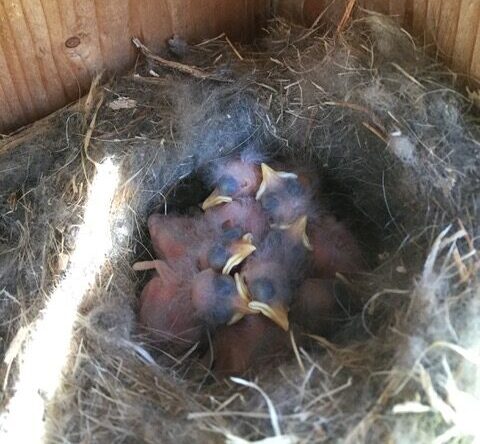Volunteer and long-time birder, Stan Wakefield, shares regular updates and pictures on bird nesting activity at BRLT’s bird boxes monitored at Oak Point Farm, Singing Meadows, Lobster Cove Meadow, Penny Lake, and Zak preserves. Data is also reported to NestWatch, a citizen-science monitoring program developed by the Cornell Lab of Ornithology and used nationwide to track the status and trends in the reproductive biology of birds. We encourage readers to check back frequently from April-August to keep up on all of the changes throughout the season.
——————————————————————————————————————-
August 1:
Here it is the first of August and the monitored bird breeding season on five Land Trust preserves has come to an end. The last nest box to fledge youngsters emptied out on July 27th at Singing Meadows. That doesn’t mean other birds aren’t still breeding out there. To be sure, many bird species are only part way through or even just getting started but we can’t monitor them the way we do the ones using nest boxes. Many species nest in the tall grasses & wildflowers of the meadows while others nest in shrubs & trees in the forests, and those nests can be difficult, if not impossible, to find. Even if we could find them, monitoring those nests could be very difficult and could cause serious problems for the nesting birds.
So, without further delay, here’s a summary of how the monitored bird breeding season went this year:
We have a total of 18 monitored nest boxes on five preserves, an increase of two boxes over last year. The preserves and the number of nest boxes at each are: Singing Meadows (6); Oak Point Farm (5); Penny Lake (3); and Lobster Cove Meadow & Zak (2 nest boxes each). Zak preserve and its two boxes was added early this year.
Four species of birds used most of the nest boxes this year (a few boxes are not used each season). There were 32 attempts to nest across all five preserves (a nest attempt is defined as at least one egg was deposited in a nest). Not all nest attempts are successful, meaning the eggs never hatch or were damaged by a predator. This season 128 eggs were deposited resulting in 111 baby birds hatching. 98 of those 111 baby birds successfully fledged. Not all eggs will hatch, either because they are infertile or there was a problem during the incubation period. And not all baby birds survive in the nest because of predation, weather extremes, or starvation (due to the loss of one or both adults).
The success rate (eggs hatching & young fledging) for each of the species that nested varies significantly. We had one black-capped chickadee who lost two separate clutches of five eggs each due to failure to hatch (0%). This seems unusual and we don’t know why this occurred. A single clutch of nine eggs deposited by a white-breasted nuthatch had a 100% success rate (all hatched & all fledged). Seven clutches of 31 tree swallow eggs resulted in 21 youngsters fledging (68%). And our eastern bluebirds with 21 clutches totaling 78 eggs had a success rate of 87% with 68 youngsters fledging.
Compared with the 2021 season, we did somewhat better this year with three species that consistently use the nest boxes (tree swallows, nuthatches, and bluebirds). Last year we had 19 tree swallows fledge from 24 eggs. The nuthatch had the same success last year as this year (9 for 9). And in 2021 our bluebirds had 53 “baby blues” successfully fledge from 70 eggs.
Finally, I’d like to thank four very dedicated volunteers who helped monitor many of these nest boxes. Michael Warren (Singing Meadows), Carolyn Lanigan (Penny Lake), and Cheryl & Mark Lorrain (Zak) devoted countless hours inspecting their nest boxes from April through July and providing me with the information (& photos) needed to report the data to the NestWatch program at the Cornell Lab of Ornithology. Thank you all!!
We’ll close with a few fun photos of adult & juvenile bluebirds provided by Cheryl & Mark Lorrain from their back yard:
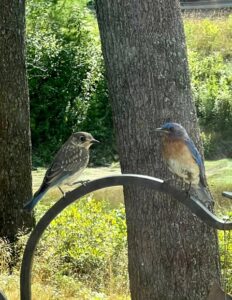

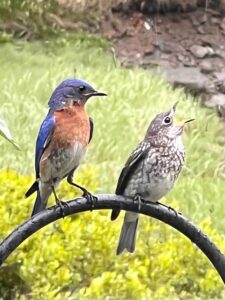
July 18:
As we said in the previous Bird Word, the bird breeding season for the nest boxes on five land trust preserves is winding down. That is seen by the fact that only two, and possibly three, nest boxes remain active, all of which are at Singing Meadows. Two of those boxes contain young bluebirds that are expected to fledge either this week or next. The third box has a new nest under construction by a species as yet undetermined. We hope to know more about that later this week.
Since our last report on July 11th, nineteen (19) young bluebirds have fledged from nests at Zak, Lobster Cove, Penny Lake, and Oak Point Farm. All of the nest boxes at these four preserves are now empty and are expected to remain so for the balance of the breeding season. Singing Meadows, the last remaining preserve with nesting activity, has five young bluebirds in each of two nests.
There are still many bird species actively engaged in breeding activity on our preserves. Song sparrows are among the most common birds that can be seen and heard in the open grassy/weedy areas on any of the preserves. American goldfinches are singing almost everywhere and will be through most of summer. Common yellowthroat warblers with their “witchety-witchety” calls can be heard often in wet, shrubby areas.
Singing Meadows is one preserve that has an excellent variety of nesting birds as seen in several excellent photographs taken recently by Stephanie Morrison. Look carefully and you’ll see that most of the birds show them with insects being taken to feed young in a nest somewhere at Singing Meadows.

Great crested flycatcher (photo by Stephanie Morrison)
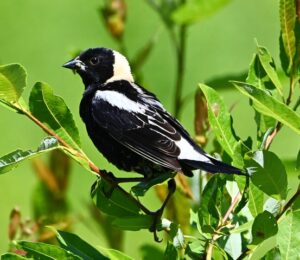
Male bobolink (photo by Stephanie Morrison)
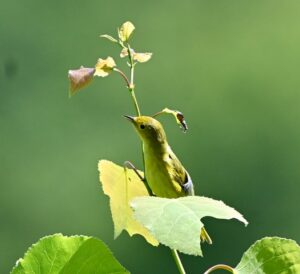
Female yellow warbler (photo by Stephanie Morrison)

Male yellow warbler (photo by Stephanie Morrison)

Female common yellowthroat warbler (photo by Stephanie Morrison)
July 11:
The bird breeding season on five Land Trust preserves is beginning to wind down but looks like it will finish in a couple of weeks with a flourish. We currently have seven active nests (all bluebirds) on those five preserves: three at Singing Meadows and one each at Lobster Cove, Oak Point Farm, Penny Lake, and Zak. These seven broods are the second ones this season for each pair of adult bluebirds. All seven nest boxes currently have fast-growing youngsters in them and they are expected to fledge within the next two weeks. If all these youngsters fledge successfully, we will have added another 37 new bluebirds to the local population. This is in addition to the 34 bluebird fledglings we had from the first broods of the season. We’ll wait to get an accurate count in a couple of weeks but we have the potential to add 71 new bluebirds to the local population this year.
Sadly, we have to report that the second effort by a black-capped chickadee to hatch her eggs at Penny Lake has failed once again. Like the first failed attempt, we are uncertain why this occurred.
Although the bluebirds are winding down their breeding season, other bird species are still active in theirs. A walk along the trails on all Land Trust preserves will reveal both the visual & aural presence of numerous red-winged blackbirds, American goldfinches, song & chipping sparrows, red-eyed vireos, house wrens, and common yellowthroat warblers (and others) all actively engaged in the annual spring/summer ritual of raising another brood of young birds.

Recently-hatched bluebirds at Singing Meadows

Female bluebird about to feed one of her offspring at Singing Meadows

American goldfinch at Singing Meadows
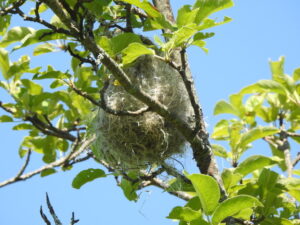
Possible cedar waxwing nest at Singing Meadows
June 30:
After some sad news last week concerning the loss of two tree swallow nests plus the loss of two bluebird nests the previous week, there’s some good news this week. Ten tree swallow youngsters successfully fledged this week at Penny Lake (3) and Oak Point Farm (7). And at Singing Meadows, bluebirds quickly re-nested in one of the nest boxes predated just two weeks ago and are currently incubating five turquoise-blue eggs!! There’s a good possibility these eggs will hatch on the 4th of July.
Bluebirds continue to do very well on all five Land Trust preserves. This week saw twenty-seven (27) bluebird eggs hatch in five nests: five each at Lobster Cove, Zak, and Penny Lake and six each at Oak Point Farm and Singing Meadows. If they all fledge successfully this will be the best bluebird season for the Land Trust yet.
The black-capped chickadee nest at Penny Lake remains active & viable. The female chickadee was incubating her eggs each day the nest box was inspected. Hopefully, this second effort will prove to be successful.
The phoebe nest with three youngsters at Oak Point Farm last week was empty this week which indicates the three (or more) youngsters seen there fledged successfully. We’ll watch that nest site next season to see if the female who used it this year uses it again.
Many other bird species are busy raising youngsters this season, and that includes feeding them not only in the nest but for varying periods of time after the youngsters have fledged. This week I heard from folks who observed adult birds feeding their youngsters away from the nest, and even had the opportunity to observe this activity myself. While observing bird activity in my back yard I was able to watch chipping sparrows and downy & hairy woodpeckers feeding their offspring in a large oak tree. The youngsters need to be fed until they develop strong flight muscles which will enable them to find the food they’ll need to survive.

Five new bluebird eggs at Singing Meadows
June 23:
After several weeks of good news about bird breeding activity on Land Trust preserves, we have some more sad news to report. Two nest boxes at Singing Meadows with young tree swallows have met with similar fates. Inspection of each nest box this week revealed that all the young birds, five in each box, had died. We don’t know the specific reason for this sad event. All ten youngsters appeared healthy at the previous inspection just three days before. There was no obvious signs of injury to them as might have occurred if a predator tried to take them. There was also no sign of any of the parent tree swallows in the area. One possibility is that the adult female for each nest box was taken by an unknown predator and the young died of starvation. This follows on the heels of two bluebird nest boxes at Singing Meadows that were predated the previous week with the loss of at least five, and possibly more, eggs. We believe that the adult pair of one of those predated nests may have re-nested and deposited eggs in a previously unused nest box a short distance away within Singing Meadows. June has been a little rough on birds at Singing Meadows but hopefully things will improve in July.
Elsewhere the news for tree swallows is better. Five youngsters at Zak and six at Oak Point Farm all fledged successfully. I was privileged to directly observe the fledging at Oak Point — just a matter of being at the right place at the right time!! The Penny Lake tree swallows should fledge in the next few days.
Last weeks report of the failure of five Penny Lake black-capped chickadee eggs to hatch turned around quickly this week by the news that five new eggs were deposited in the same nest. This is an example of “double-clutching” by a bird whose first clutch of eggs failed to hatch or were lost to a predator. Hopefully these eggs will have a better outcome.
Bluebirds at all five preserves are doing well so far. Five eggs each at Oak Point, Penny Lake, Lobster Cove, and Zak should hatch next week. Eleven bluebird eggs in two nests at Singing Meadows are currently being incubated. If all hatch & fledge successfully, this will be the second batch of bluebird youngsters in all five locations this season.
Finally, there’s news of another species breeding on two BRLT preserves, but not where you might expect to find them. While performing volunteer work this week, Alan Bellows observed a nest containing several young phoebes in the kiosk at Ovens Mouth West. Not to be outdone, the staff at Oak Point observed at least three young phoebes in a nest perched on the narrow trim above a window under the breezeway leading to the main entrance to the farm house.
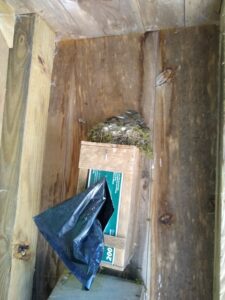
Phoebes at Ovens Mouth Kiosk

Phoebe nest over window
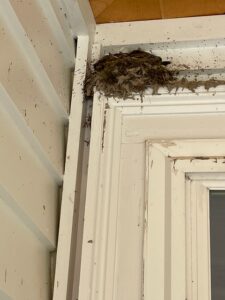
Phoebe nest over window
June 16:
The 2022 bird migration has pretty much come to a close, but the local bird breeding season continues apace. The singing and calling of birds that was so noticeable just two weeks ago has become much quieter now that many of our local birds are on nests and don’t want to bring attention to themselves. Some birds (such as song and chipping sparrows, robins, goldfinches, and cardinals) continue to sing and call quite loudly as they declare their territories and try to attract mates.
As forecast last week, nine young white-breasted nuthatches fledged successfully at Oak Point Farm. Unfortunately, the five eggs of a black-capped chickadee failed to hatch at Penny Lake.
Tree swallows are doing very well at Zak, Oak Point, Penny Lake, and Singing Meadows. Five growing youngsters at Zak and six more at Oak Point Farm are expected to fledge this weekend. There are 20 more fast-growing young tree swallows at Penny Lake, Oak Point, and Singing Meadows that should fledge in the coming 7 to 10 days.
With two exceptions, eastern bluebirds continue to do well at all five BRLT preserves with nest boxes. A total of 27 bluebird eggs are currently being incubated in six nests and one new bluebird nest (with no eggs yet) has been constructed. One of the new nest boxes at Singing Meadows is being used for the very first time!
In addition to the failure of the Penny Lake chickadee eggs to hatch, we had our first two cases of nest predation at Singing Meadows. The eggs in two bluebird nests were removed or damaged this week by an unknown predator, quite possibly house sparrows which are known to evict nesting bluebirds and destroy or remove their eggs. As a result, at least five bluebird eggs (and possibly more) have been lost. Unfortunate as this may be, it’s possible that the affected bluebirds could try to nest again this season.
June 8:
The 2022 bird breeding season continues at full speed on five BRLT preserves. As of the end of May, 30 young bluebirds had joined the family and so far this month, the pace shows no signs of slowing down.
As of today there are at least nine new bluebird eggs in four different nests and three more bluebird nests in which eggs are expected to be deposited in the coming days. These nests are located on five land trust preserves. If the average of five eggs are deposited in each of these seven nests, we have the potential to add another 35 more young bluebirds to the peninsula. And that’s counting only the bluebirds we know of since these are monitored nest boxes. There could easily be many times more young bluebirds added to the population that are breeding in homeowner nest boxes all across the peninsula!
Tree swallows are the next most numerous species breeding on four land trust preserves with six nest boxes currently containing a combination of 31 eggs and/or young.
The nine white-breasted nuthatch youngsters at Oak Point Farm are expected to fledge this weekend and the five black-capped chickadee eggs at Penny Lake should hatch this week.
Many other bird species are breeding on BRLT preserves and backyards all over the Boothbay peninsula. Just a few of those are: eastern kingbirds, red-wing blackbirds, tufted titmice, belted kingfishers, ruby-throated hummingbirds, eastern phoebes, great crested flycatchers, juncos, red-breasted nuthatches, downy woodpeckers, gray catbirds, northern cardinals, Baltimore orioles, several warbler species, and broad-winged hawks. All of these birds, and many more, can be seen & heard on your land trust preserves.
May 31:
As anticipated (and forecast) in the previous Bird Word, the land trust has now helped to unleash 30 new eastern bluebirds on the Boothbay peninsula. The last ten young “blues” fledged late last week at Oak Point Farm and Zak preserves (5 each). We expect a few of the adult bluebird pairs to nest a second time this season.
As of this week, we’re seeing nine white-breasted nuthatch babies grow quickly at Oak Point and are watching several (6) tree swallow nests at Zak, Oak Point, Penny Lake, and Singing Meadows containing a total of 26 eggs and 5 newly-hatched youngsters. Finally, the NestWatch team is keeping an eye on five black-capped chickadee eggs at Penny Lake that are expected to hatch any day now.
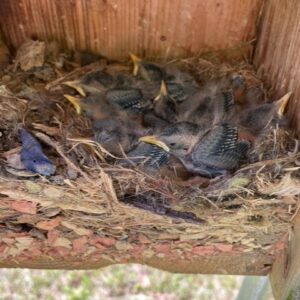
Fast-growing white-breasted nuthatches at Oak Point (See the previous Bird Blog to see how much these birds have grown in a week)
The annual spring migration is nearing an end but there’s still lots of bird activity all around us. Recent bird walks on land trust preserves, the Coastal Maine Botanical Gardens, and Florida Lake in Freeport revealed the presence of many colorful migrant birds preparing to nest in our area, plus one bird that’s not frequently seen in Maine.
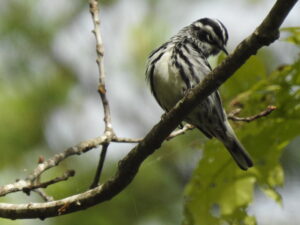
Black-and-white warbler at CMBG
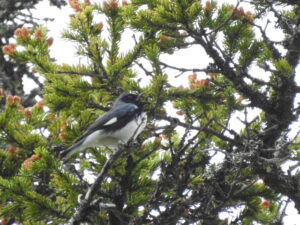
Singing black-throated blue warbler at CMBG

One of about 30 cedar waxwings spotted at CMBG
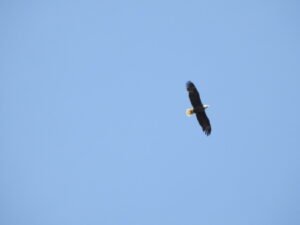
Bald eagle in flight over Oak Point

Canada geese with 5 growing goslings at Oak Point
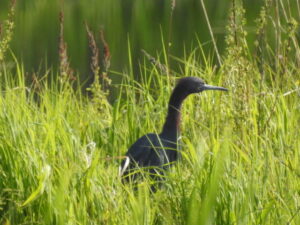
A seldom-seen little blue heron not too far from Boothbay region, at Florida Lake near Freeport
May 22:
May has been a very busy month for the multiple bird species using nest boxes on BRLT preserves. So far, 20 baby bluebirds have already fledged from 4 nest boxes on 3 different land trust preserves. This coming week we expect another ten bluebirds will fledge for a total of 30 new bluebirds in May alone. That may be a new record for the land trust!! And don’t forget — some of these bluebird pairs are likely to nest for a second time later this summer, so we could be adding several more new bluebirds to the total.
Following behind the bluebirds are several other bird species using nest boxes on BRLT preserves. Tree swallows are the most numerous species and are currently nesting on three preserves: Oak Point Farm, Zak, and Singing Meadows. There’s the possibility the swallows will also use a nest box at Penny Lake. The nine eggs of a white-breasted nuthatch nesting at Oak Point just hatched on May 19th and a black-capped chickadee started egg-laying at Penny Lake in mid-May.
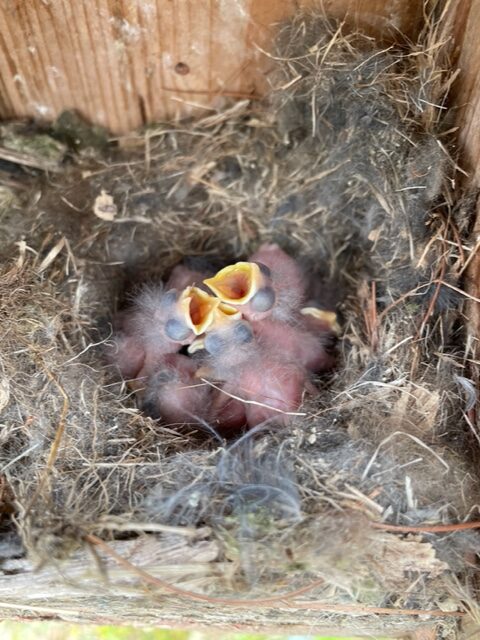
Recently-hatched white-breasted nuthatches at Oak Point
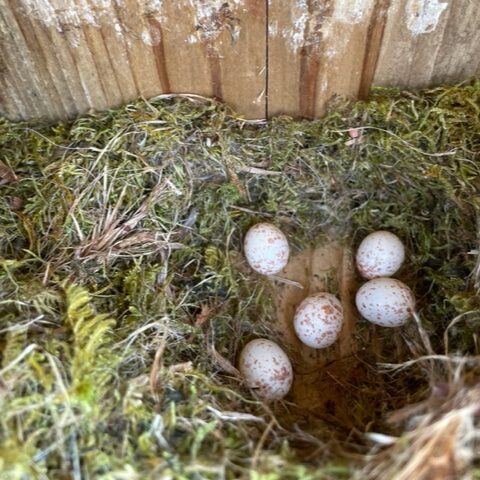
Black-capped chickadee eggs at Penny Lake
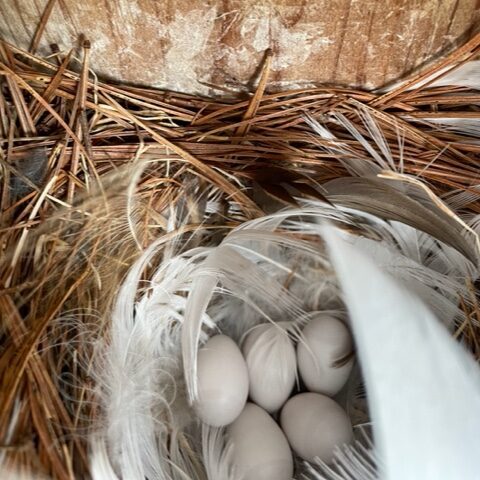
Tree swallow eggs at Zak
The spring migration is still active but is expected to slow over the next couple of weeks. Many of these birds are stopping in Maine to breed while many others will continue to their breeding grounds in Canada and the Arctic. Among those seen and preparing to nest on the Mid-Coast are Baltimore orioles and bobolinks (Singing Meadows) and many colorful warblers such as chestnut-sided, magnolia, blackburnian, yellow-rumped, black-and-white, black-throated green, common yellowthroat, and American redstart. All of these birds are quite visible and vocal right now as they establish breeding territories and attract mates, but once nesting has begun they will become silent and difficult to find. Now is the time to get out on your land trust preserves to see this colorful array of bird life.
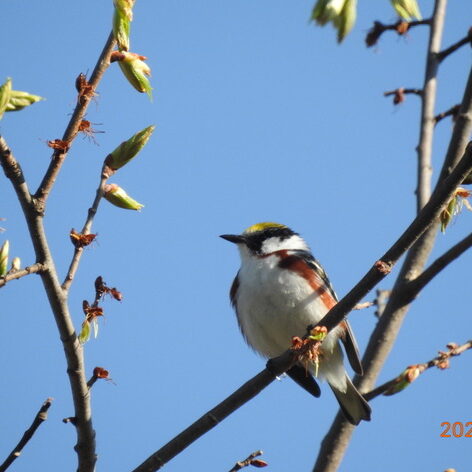
Chestnut-sided warbler
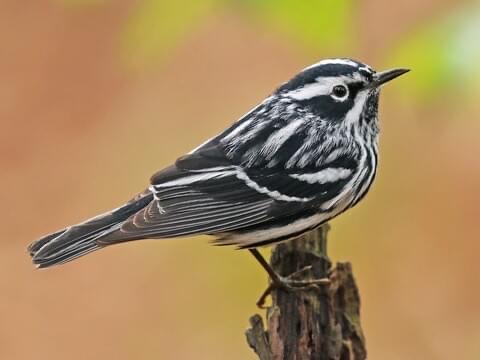
Black-and-white warbler
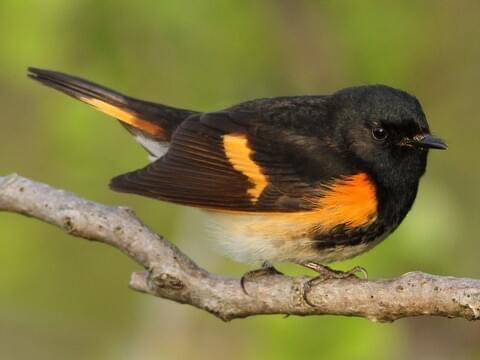
American redstart
May 12:
Our land trust nest box monitor volunteers are staying very busy of late. As of May 12th, 13 of 18 nest boxes on five BRLT preserves now have baby birds (5), eggs (3), or nests under construction (5). At least four bird species (bluebird, white-breasted nuthatch, tree swallows, and black-capped chickadee) are using these nest boxes. Bluebirds make up the largest number of “tenants” (7) with tree swallows (2) and a nuthatch (1) rounding out the top ten.
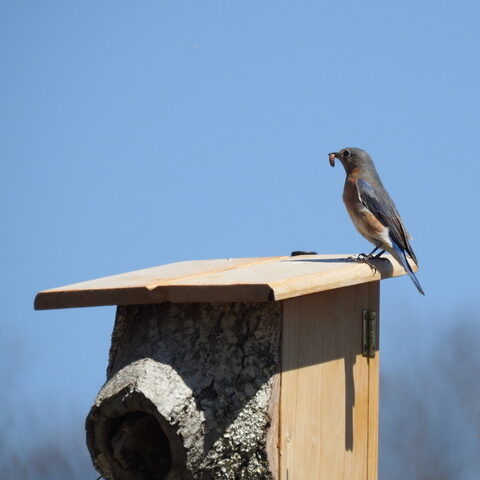
Female bluebird getting ready to feed a hungry youngster.

These nuthatch eggs will hatch any day now.
Zak preserve is doing very well in its first year with two nest boxes. Bluebirds are currently raising four youngsters while a tree swallow has just gotten started depositing eggs.
Ruby-throated hummingbirds have returned to our peninsula. Nectar feeders can be very helpful to these “flying gems” as they make their way beyond Maine into southern Canada. Please be sure to keep nectar feeders clean, especially during July & August. The correct ratio of water to sugar is 4 to 1, and it’s not necessary to boil the water before mixing in the sugar. And don’t add any red food coloring: it isn’t necessary if a red nectar feeder is used.
The woodlands in all BRLT preserves are alive with a bewildering variety of songs and calls of over 100 bird species, such as chestnut-sided warblers, great crested flycatchers, ovenbirds, and goldfinches. Many of these birds are just “passing through” on their way to breeding grounds in Canada and the Arctic, but many are also staying right here in Maine to raise another generation of birds. May is an excellent month to get out and see (and hear) this annual spectacle.
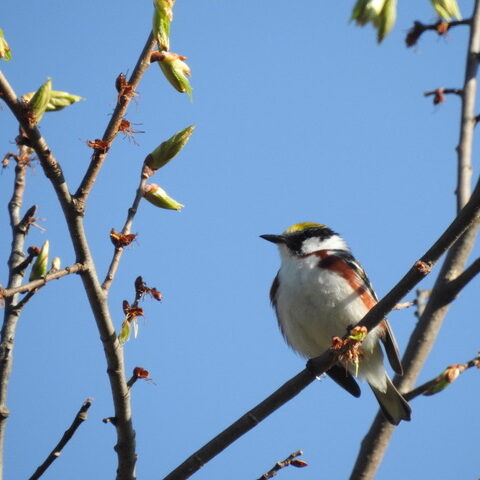
Chestnut-sided warbler
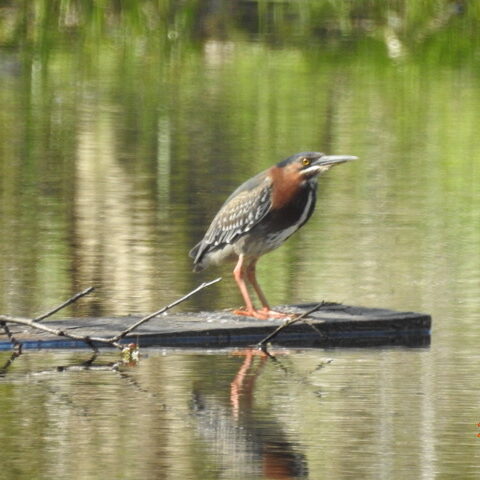
Green heron

Downy woodpecker

Great blue heron
May 4:
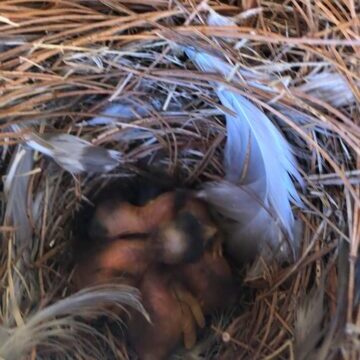
Four newborn bluebirds at Penny Lake

Five new baby bluebirds at Lobster Cove
At Oak Point, two nests now have eggs being incubated with hatching expected within the next week or so. Bluebirds are tending to five eggs in one nest while a white-breasted nuthatch is carefully incubating nine eggs. This is the 3rd consecutive year a nuthatch (very likely the same one) has used one specific nest box and deposited the same number of eggs (9).

Bluebird eggs at Oak Point Farm
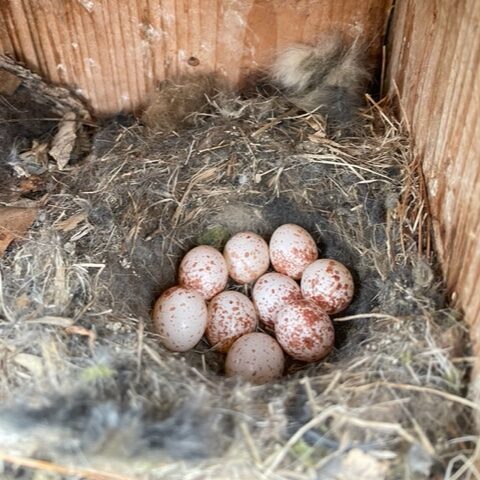
White-breasted nuthatch eggs at Oak Point Farm
Zak preserve has its first bluebird nest with eggs that were deposited in late-April. Five new bluebirds are expected to hatch any day now. The other nest box at Zak has a complete tree swallow nest but no eggs have been deposited yet.
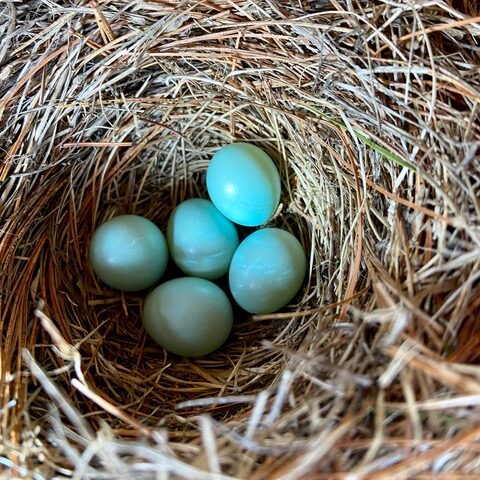
Bluebird eggs at Zak preserve

Tree swallow nest at Zak preserve
Singing Meadows preserve now has bluebird eggs in three of the six nest boxes located there. Two of those nest boxes have five eggs each and one has six eggs. All 16 of those eggs are being carefully incubated and are expected to hatch very soon.
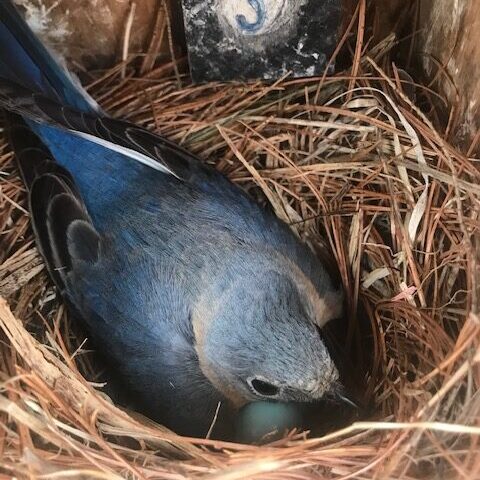
Female bluebird incubating her 5 eggs at Singing Meadows
The spring migration is well underway now on the midcoast and provides many opportunities to see some very colorful birds as they make their way to breeding territories within and north of Maine. Visit a nearby land trust preserve and see what you can find!
April 18:
The signs of the spring bird migration are now unmistakable here in the Boothbay area. We’re hearing a wide variety of birds calling and singing, which are the ways birds use to attract mates and declare their breeding territory. Northern cardinals, song sparrows, and American robins are especially vocal right now and can be heard almost everywhere. We’re seeing the males of many species transitioning into their brilliant colors and/or patterns, which also serve to attract mates. American goldfinches and common loons are good examples of this transition from drab winter feathers into bright breeding plumage.
Breeding activity is also well underway now, particularly among our eastern bluebirds who seem to have started a few days earlier than last year. Not only have nests been built in many nest boxes on five BRLT preserves, but eggs have been deposited in many of those nests. Lobster Cove Meadow was the first preserve to see this activity and as of April 14th this nest already had 5 eggs in it. Not too far behind are Singing Meadows, Penny Lake, and Oak Point Farm with anywhere from one to two eggs in several nests, and probably more by the time this is published. Zak preserve is expected to have eggs deposited sometime during the week of April 18th.
Evidence of spring migration is exemplified not only by the arrival of birds from the south, but also by the departure of birds from here to their northern breeding areas. Among the birds that spend the winter here in the Boothbay area and have now departed (or will soon) are several species of sea ducks, such as three types of scoters (black, white-winged, and surf), plus harlequin, Barrow’s goldeneye, long-tail, and bufflehead ducks. Interesting sightings on BRLT preserves of returning birds during the recent week of the migration include: turkey vultures, broad-winged hawks, tree swallows, ospreys, belted kingfishers, palm warblers, eastern phoebes, chipping sparrows, plus a few others. Many more returning species will be seen & heard in the weeks to come. A walk through any BRLT preserve will expose you to the varied sights & sounds of the spring migration.
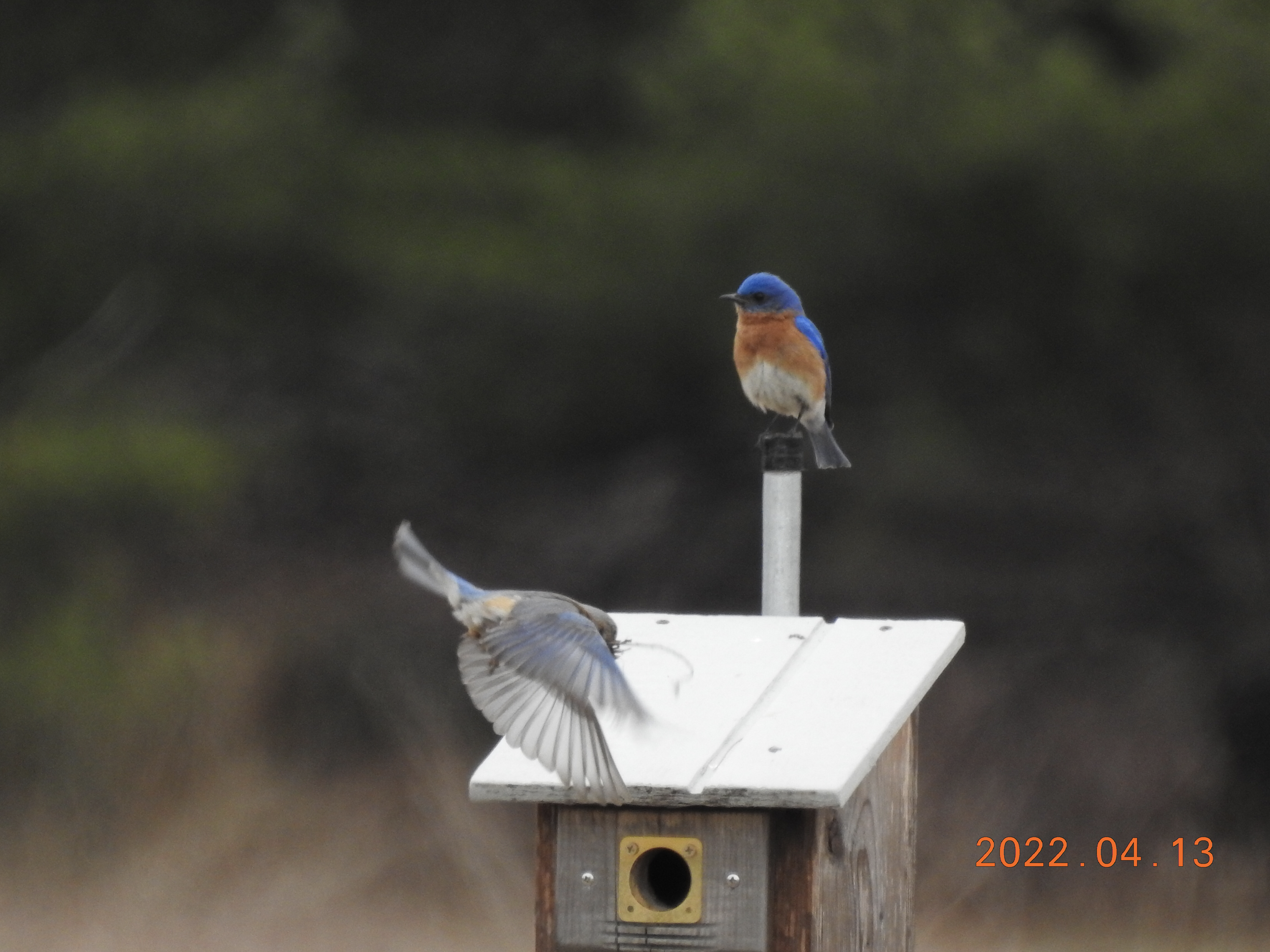
Bluebird pair at Zak
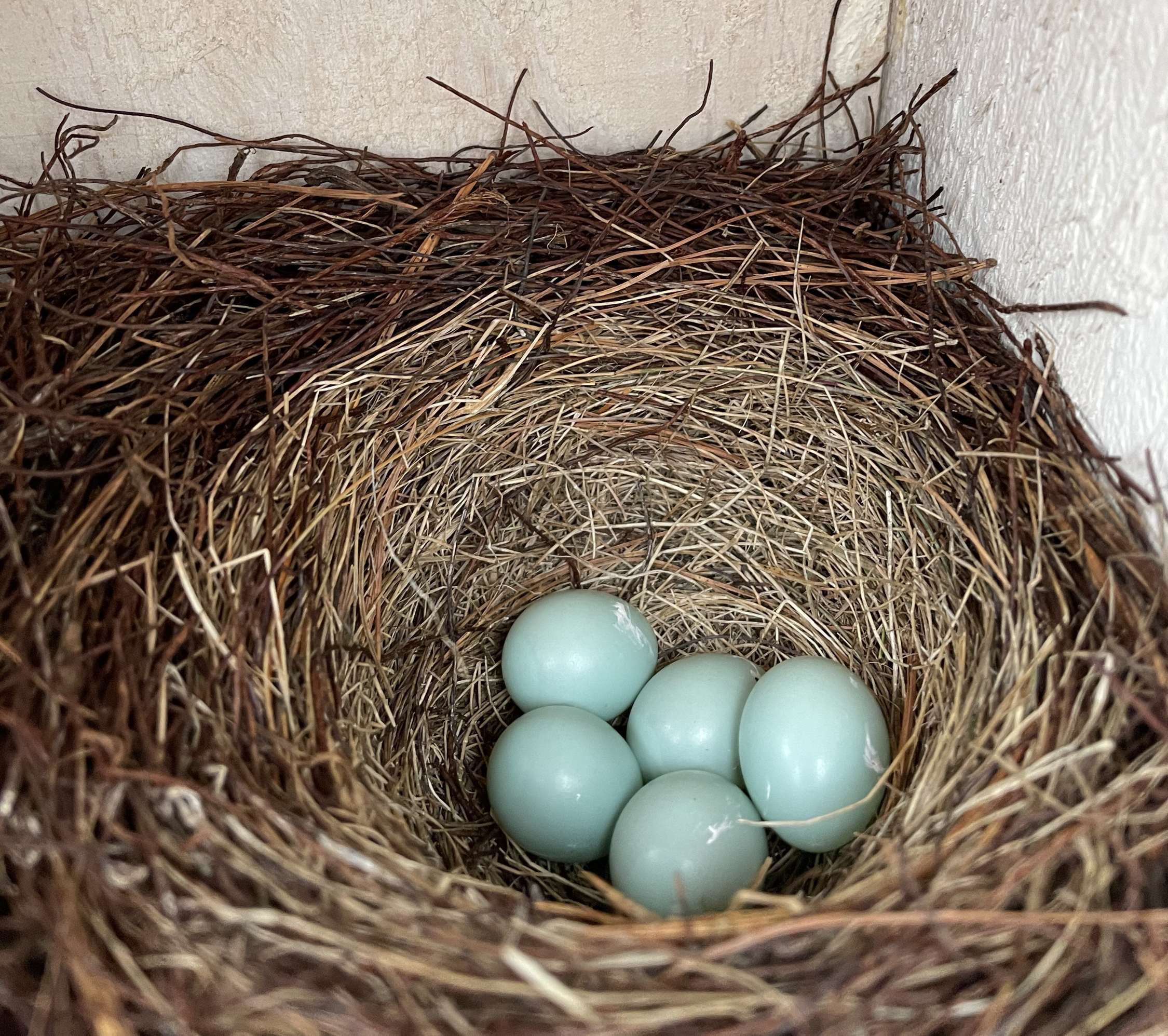
Bluebird nest with 5 eggs at Lobster Cove Meadow
April 12:
Bird activity is really picking up on five of BRLT’s preserves (and probably on all of them for that matter). Recent inspections of 19 nest boxes at Singing Meadows, Zak, Penny Lake, Lobster Cove Meadow, and Oak Point Farm over the past two weeks are showing signs that Eastern Bluebird nesting activity has begun in earnest. Bird observation walks at all five preserves also illustrate that the spring bird migration is well underway.
As of April 10th there are five complete nests and five more nests in various stages of construction on all five of the above preserves. Of the five complete Eastern Bluebird nests, one (at Lobster Cove) had a single egg deposited (on April 12, there were 2 more eggs in this nest–stay tuned for more updates). This is a little earlier than what we saw last year.

First egg of the season (Eastern Bluebird) in a nest at Lobster Cove Meadow
Additional eggs in all five nests are anticipated over the next week or two and more completed nests are expected as well.
Some strong signs that the spring migration is underway include recent sightings of several bird species returning from their wintering grounds. Red-wing blackbirds, tree swallows, belted kingfishers, eastern phoebes, song sparrows, turkey vultures, great blue herons, wood ducks, and a merlin have been seen on BRLT preserves in just the past two weeks. And many more species will be arriving over the next month! So pull out your binoculars and start scanning the skies.
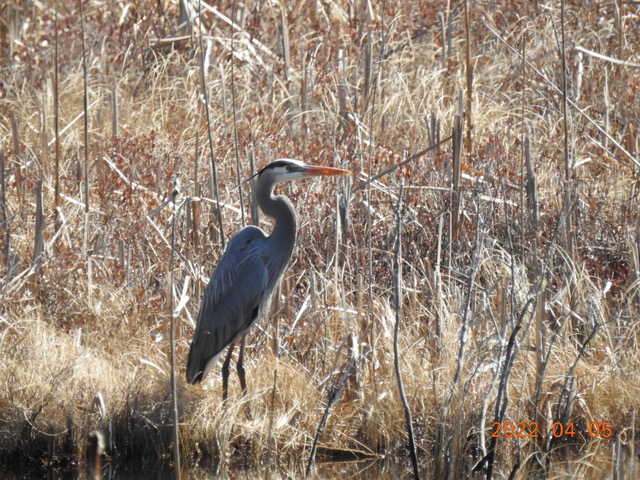
Great blue heron at Lobster Cove Meadow
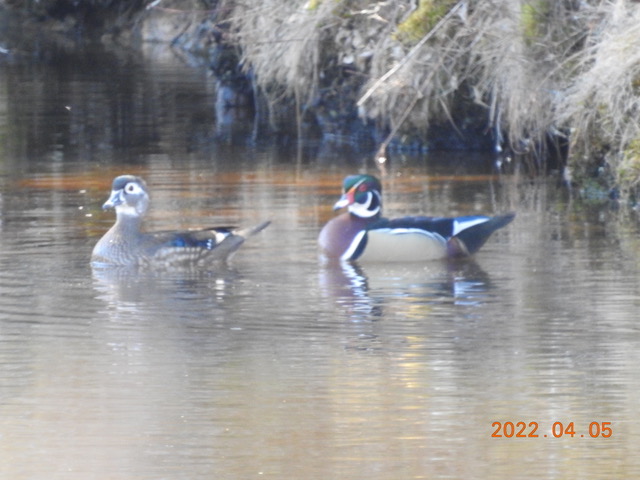
Wood duck pair at Oak Point Farm
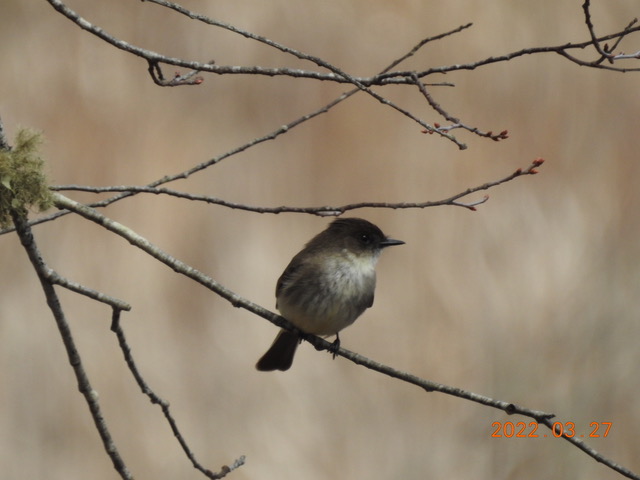
Eastern phoebe at Lobster Cove Meadow
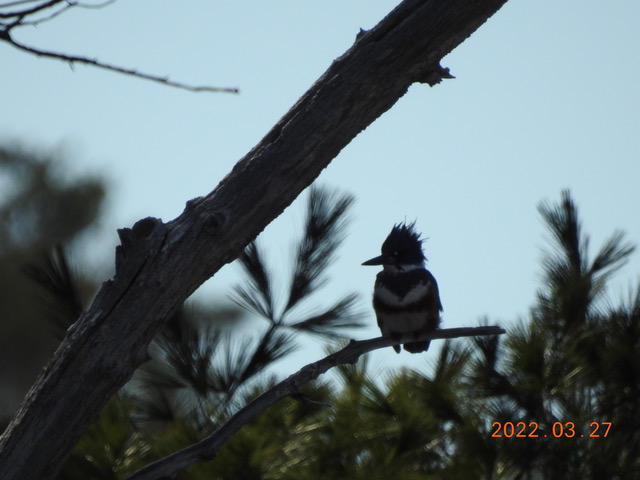
Belted kingfisher at Oak Point Farm
Another recent sighting of interest was a juvenile (2nd year) bald eagle chasing a duck over Townsend Gut near Oak Point. As the eagle closed in, the duck dove into the water to escape the eagles talons and the eagle had to look elsewhere for its lunch.
These observations, and much more, await at the land trust preserves. Happy birding!
March 23:
Red-winged blackbirds have starting arriving on their breeding locations at Lobster Cove and Singing Meadows. A few males were observed calling in the freshwater marsh at Lobster Cove today (3/21) and adjacent to a marshy area at Singing Meadows yesterday (3/20). More males will be arriving soon to claim their preferred breeding sites and will be followed by females in April.
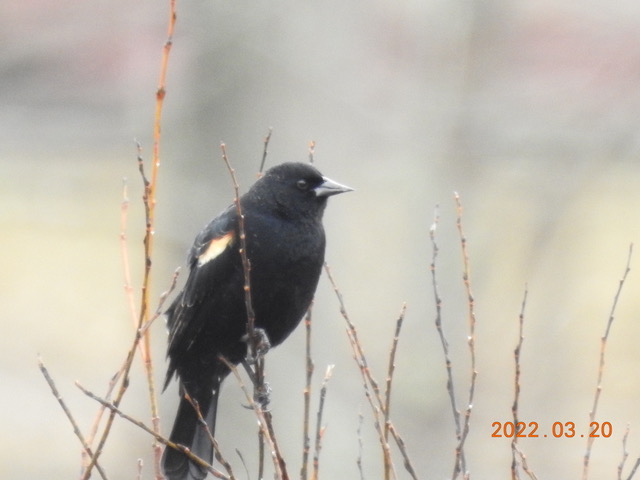
March 19:
In anticipation of the wild bird breeding season getting underway at selected BRLT Preserves, nest boxes have been cleaned out, installed, relocated, and/or replaced with more natural-looking front entries. These beautiful new entrances were custom-made using natural tree cavities by Gary Arnold. We hope these “upgraded” nest boxes will be accepted by the bluebirds.

Natural entry nest box at Singing Meadows
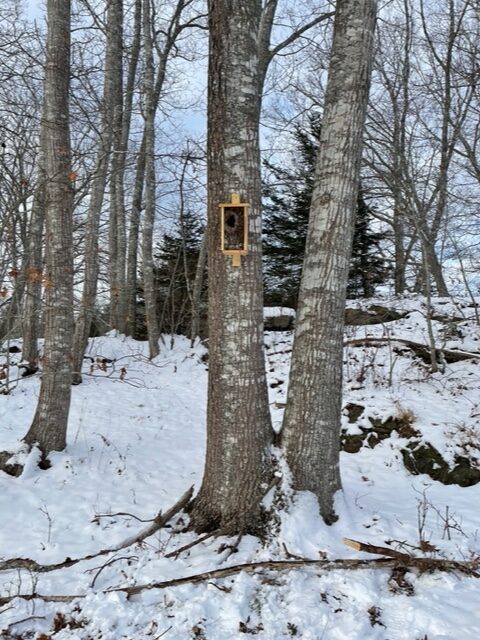
One of two new nest boxes at Oak Point Farm made for small owls and/or kestrels
In addition, pre-season surveys at Singing Meadows, Lobster Cove Meadow, and Oak Point Farm revealed the presence of many Eastern Bluebirds in the immediate or general vicinity of nest boxes. Family groups of 3 to 4 bluebirds have been seen at each of the three preserves listed above. There was even evidence that several bluebirds used a nest box at Lobster Cove Meadow as an overnight roosting box during some of those bitterly cold nights this winter. Two new nest boxes have been installed at Zak Preserve in the hopes of attracting bluebirds to this location. Both nest boxes will be visible from the trails near the parking area.
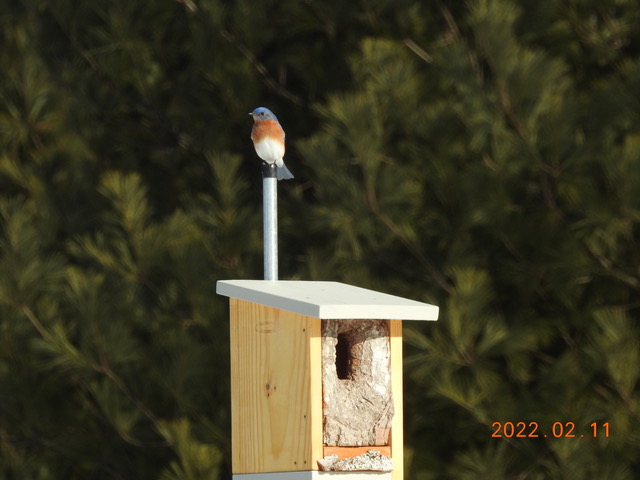
Male bluebird at Oak Point Farm
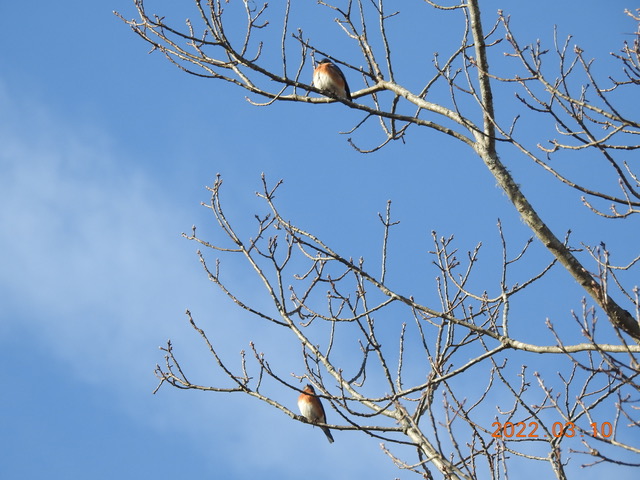
Bluebirds at Lobster Cove Meadow


